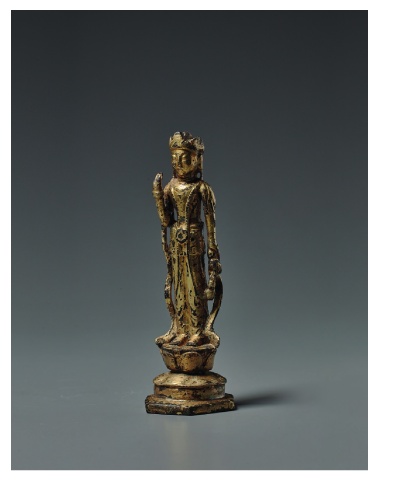Page 393 - japanese and korean art Utterberg Collection Christie's March 22 2022
P. 393
252
A GILT-BRONZE STANDING SCULPTURE OF A
BODHISATTVA
THREE KINGDOMS PERIOD-SILLA DYNASTY (7TH-8TH
CENTURY)
The slender figure posed on an integral lotus stand holding the
identifying urn in left hand, ornamented with a garland necklace
across the torso and drapery flowing in long, looping pleats from the
waist and further drapery that enwrapped the arms and that ends in
an upward sweep above the feet, the head cast with a raised crown;
the reverse side of the figure with a mounting peg at the back of the
shoulder
5¿ in. (13 cm.) high
$8,000-12,000
Elegantly outfitted in the sumptuous trappings of an Indian
prince of old, this gilt bronze sculpture represents a bodhisattva,
a benevolent being who has attained enlightenment but who has
postponed entry into nirvana in order to assist other sentient beings
in gaining enlightenment. Bodhisattvas generally are depicted with
a single head, two arms, and two legs, though they in fact may be
shown with multiple heads and limbs. Richly attired, bodhisattvas,
who may be presented either standing or seated, are represented
with long hair often arranged in a tall bun atop the head and often
with long strands of hair cascading over the shoulders. As seen
here, a crown sometimes surrounds the high topknot. Bodhisattvas
wear ornamental scarves, dhotis of rich silk brocade, and a wealth
of jewelry that typically includes necklaces, armlets, bracelets, and
anklets; this figure’s beaded necklace descends from the neck to the
chest, passes through a medallion at the waist, falls to the knees in
two broad ellipses, and then loops around to the figure’s back. Like
Buddhas, bodhisattvas have distended earlobes; some wear earrings,
others do not.
Closely related sculptures are in the collections of the Harvard
Art Museums (1943.53.75) and of the National Museum of Korea
(NMK), Seoul (M335 and Sinsu 3298; see: National Museum of
Korea, ed., Masterpieces of Early Buddhist Sculpture, 100 BCE–700
CE, Seoul: National Museum of Korea, 2015, pp. 186-187, no. 92,
M335, and pp. 200-201, no. 100, Sinsu 3298). This sculpture bears
a striking visual and stylistic similarity to NMK M335, which the
NMK curators date to the seventh century and assign to the Baekje
Kingdom (c. 18 BC–AD 660), just as it also shows kinship to the
seventh-century Harvard figure. The base’s polygonal lower edge
finds parallels in the bases of the Harvard sculpture and of NMK
Sinsu 3298, which the NMK curators date to the seventh century
and ascribe to the Silla Kingdom (57 BC–AD 935).

